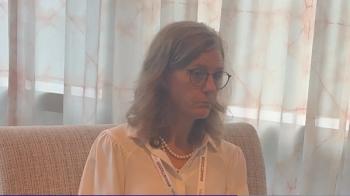
- Oncology Vol 28 No 4_Suppl_1
- Volume 28
- Issue 4_Suppl_1
(S012) Prognostic Value of Radiographic Extracapsular Extension in Locally Advanced Non-Oropharyngeal Head and Neck Squamous Cell Cancers
Previous data from our institution suggest that imaging evidence of extracapsular extension, identified on pretreatment CT scans, independently predicts for worse distant control and survival for oropharyngeal squamous cell cancer (OPC) patients undergoing radiation therapy. In this present study, we sought to validate these findings in non-OPC head and neck squamous cell cancers.
Jerry T. Liu, MD, Benjamin H. Kann, BS, Michael Buckstein, MD, PhD, Richard Bakst, MD, Eric Genden, MD, Marshall Posner, MD, Peter Som, MD, Vishal Gupta, MD; Icahn School of Medicine at Mount Sinai
Background: Pathologic extracapsular extension (pECE) in locally advanced head and neck squamous cell cancers (HNCs) is associated with poor prognosis. Previous data from our institution suggest that imaging evidence of extracapsular extension (rECE), identified on pretreatment CT scans, independently predicts for worse distant control and survival for oropharyngeal squamous cell cancer (OPC) patients undergoing radiation therapy. In this present study, we sought to validate these findings in non-OPC HNCs.
Methods: From our departmental database, 121 patients with locally advanced (cN+) non-OPC HNCs were treated in our department with definitive or adjuvant radiation therapy (± induction chemotherapy and/or concurrent chemotherapy) from 2006–2012. Thirteen patients had recurrent disease at presentation, seven patients discontinued treatment due to noncompliance or other factors, two patients underwent reirradiation of the treated region, and three patients did not have accessible pretreatment CT studies. The remaining 96 patients (nasopharynx [n = 18], hypopharynx [n = 16], larynx [n = 22], oral cavity/lip [n = 24], nasal cavity/sinus [n = 3], and unknown primary [n = 13]) were selected for this study, and all pretreatment CT studies were reviewed by our head/neck radiologist for evidence of rECE. Patients were stratified by presence of rECE, age, gender, race (black vs nonblack), smoking history (≥ 10 vs < 10 pack-years), Eastern Cooperative Oncology Group (ECOG) performance status (PS), T-stage, N-stage, overall stage, and treatment type. Univariate and multivariate analyses were performed regarding the impact of these factors on locoregional control (LRC), distant control (DC), progression-free survival (PFS), and overall survival (OS). Patients who underwent initial neck dissection (n = 42) were analyzed for the sensitivity, specificity, positive predictive value (PPV), and negative predictive value (NPV) of rECE as a predictor for pECE.
Results: At a median follow-up of 27 months (range: 3–94 mo), 56 (58%) patients had rECE and 40 (42%) did not. These groups were well balanced for median age, gender, race, smoking history, PS, and treatment type. Patients with rECE were more likely to have cN2–3 disease versus those without rECE (86% vs 75%, respectively; P = .028). Patients with rECE had significantly worse LRC (3-yr: 67% vs 88%; P = .032), DC (3-yr: 69% vs 88%; P = .017), PFS (3-yr: 57% vs 79%; P = .017), and OS (3-yr: 57% vs 87%; P = .018). On multivariate analysis, rECE was found to be an independent predictor for worse LRC (hazard ratio [HR] = 3.83; 95% confidence interval [CI], 1.36–10.79), DC (HR = 3.71; 95% CI, 1.24–11.12), PFS (HR = 2.70; 95% CI, 1.19–6.11), and OS (HR = 2.87; 95% CI, 1.06–7.81). For patients who underwent definitive surgery, the sensitivity, specificity, PPV, and NPV of rECE to predict for pECE were 70%, 67%, 79%, and 56% respectively.
Conclusions: As previously reported for OPC, presence of rECE, compared with lack of rECE, portends worse prognosis for patients with non-OPC HNCs undergoing definitive or adjuvant radiation therapy. For these patients, presence of rECE is an independent predictor for worse LRC, DC, PFS, and OS. Further studies, with larger cohorts and longer follow-up, are needed to validate these findings and determine how rECE can be used to guide clinical management in these patients.
Proceedings of the 96th Annual Meeting of the American Radium Society -
Articles in this issue
Newsletter
Stay up to date on recent advances in the multidisciplinary approach to cancer.



















































































